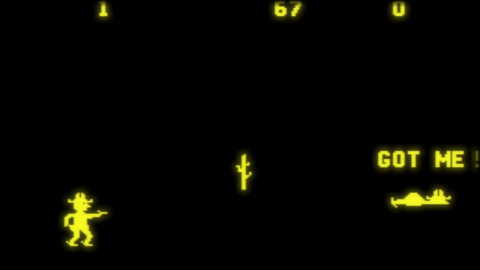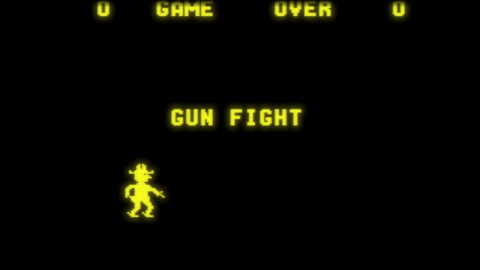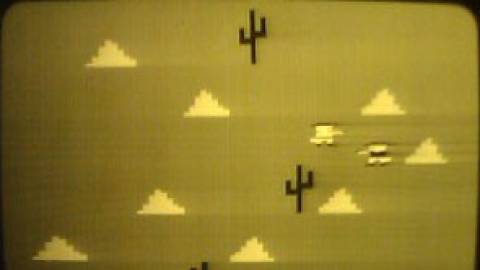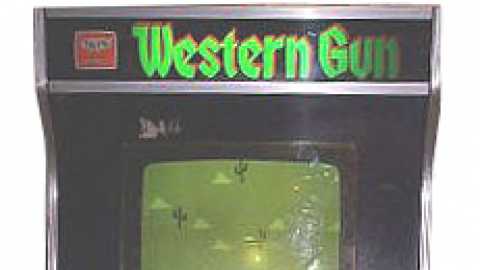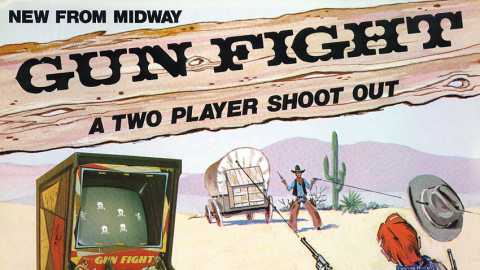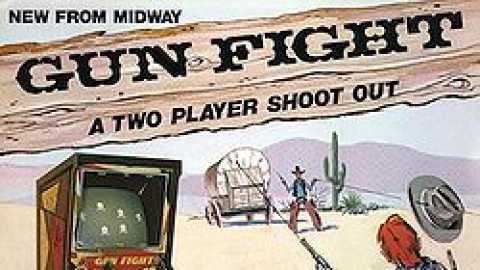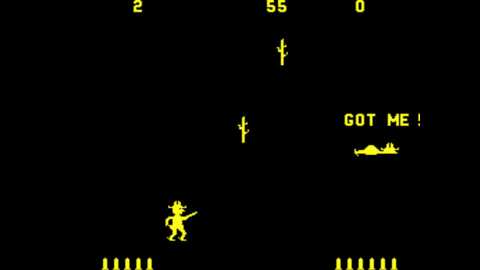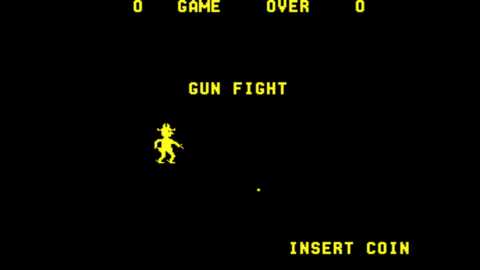Overview

It was a historically significant game, and a success in the arcades. Gun Fight was the third hit Taito game licensed by Midway in North America (after Basketball and Speed Race / Wheels). Its success paved the way for Japanese video games in the North American market. In gameplay terms, it was the first game to depict human-to-human combat, the first on-foot shooter, the first open-world video game, and the first action-adventure game. The US release of Gun Fight was also the first microprocessor-powered video game. It was ported from Taito's original TTL (transistor-transistor logic) configuration to the Intel 8080 by Nutting Associates.
The theme of the game involves two Wild West cowboys armed with revolvers and squaring off in a duel. Whoever shoots the other cowboy first wins the duel. Unlike in a real-life duel, however, both cowboys get numerous opportunities to duel in order to score points (one point per successful draw). The game was included in GameSpy's "Hall of Fame" in 2002.
The game was a hit in North America, where it sold more than 8,000 units. In 1976, it was the third highest-grossing game in the region, just behind Speed Race / Wheels, another previous Taito game licensed by Midway. Gun Fight's success laid the foundations for the shooter genre.
Gameplay and story
Western Gun was an early, on-foot, multi-directional shooter, that could be played in single-player or two-player. It also introduced video game violence, being the first video game to depict human-to-human combat, and the first to depict a gun on screen. The game also introduced dual-stick controls, using two distinct joystick controls per player, with one eight-way joystick for moving the computerized cowboy around on the screen and the other for changing the shooting direction. Unlike later games, Western Gun has the main joystick on the right instead of the left. It was also the first known video game to feature game characters and fragments of story through its visual presentation, marking the beginning of cinematic elements in video games. The player characters used in the game represented avatars for the players, and would yell "Got me!" when one of them is shot.
Other features of the game included obstacles between the characters, such as a cactus, and in later levels, pine trees and moving wagons; these objects serve to provide cover for the players and can be destructible. The guns have limited ammunition, with each player given six bullets; a round ends if both players run out of ammo. Gunshots can also ricochet off the top or bottom edges of the playfield, allowing for indirect hits to be used as a possible strategy.
Western Gun vs. Gun Fight
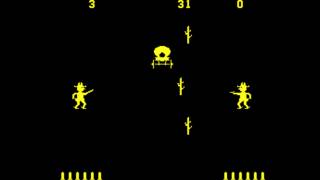
Western Gun was Taito's original Japanese version, also released in Europe, while Gun Fight was Midway's North American adaptation. There are differences between Western Gun and Gun Fight:
The original Western Gun was the first open-world video game, the first action-adventure video game, and the first real-time tactical cover shooter. The two cowboy gunslingers had free-roaming movement across a single-screen open-world environment, littered with cacti and mountains that could be used as cover, while attempting to shoot each other. However, Western Gun had more primitive sprite graphics and animation, and used discrete-logic hardware (lacking a microprocessor).
The North American version Gun Fight introduced a microprocessor, allowing more detailed larger sprite graphics and smoother animation, but limited the gameplay. In Gun Fight, each player's movement was limited to their own side of the screen, whereas the original Japanese Western Gun had free-roaming movement across anywhere on the screen. Gun Fight also reduced the scale of the environment, with mountains no longer being present.
Development and technology
Taito employee Tomohiro Nishikado designed Western Gun as a character-based game with fragments of story. While it lacked the cut-scenes or fleshed-out character designs of later games due to technological limitations, the game presented early cinematic elements, through artwork of cowboys in the Wild West on the arcade cabinet which matched the in-game graphics featuring cacti, covered wagons, rocks, and human characters. In contrast to earlier games which used miniature shapes to represent abstract blocks or spaceships, Western Gun featured cartoon-like human characters, influenced by Japanese manga / anime.
Taito licensed its game Western Gun to Midway for release in North America, the second such license after the 1974 vertical-scrolling driving/racing game Speed Race, also designed by Tomohiro Nishikado. The title Western Gun, while making perfect sense for Japanese audiences in that it conveys the setting and theme as simply as possible, was considered to have sounded odd to American audiences, so it was renamed Gun Fight instead for its American localization. The manga-inspired artwork in the original Japanese version was also changed for release in North America, where most players were initially unaware of the game's Japanese origins.
Tomohiro Nishikado's original Western Gun design was based on discrete logic, like most arcade video games of the time. When Dave Nutting adapted it for Midway, he decided to base it on the Intel 8080, which made Gun Fight the first video game to use a microprocessor. Nishikado believed that his original version was more fun, but was impressed with the improved graphics and smoother animation of Midway's version. This led him to design microprocessors into his subsequent games, including the blockbuster 1978 shoot 'em up hit Space Invaders. Gun Fight uses a black-and-white raster monitor and a yellow screen overlay.
Ports
In 1977, the game was introduced to the home market with its port to the Bally Astrocade console, which included a colour version of the game, Gunfight, within the system's ROM as a built-in game.
In 1983, Epyx also ported Gun Fight and another Midway game, Sea Wolf II, to the Atari 8-bit computers, and released them in a compilation, Arcade Classics: Seawolf II / Gun Fight. In 1987, Interceptor Software ported Gun Fight to the Commodore 64. As late as 2001, another version of the game, Gunfight, was released by Manuel Rotschkar for the Atari 2600.
Popular Culture
The opening chiptune used in Gun Fight is sampled by the hit 1978 song "Computer Game" by Yellow Magic Orchestra (Japanese electronic music band consisting of Haruomi Hosono, Ryuichi Sakamoto, and Yukihiro Takahashi).
In the hit 1978 hit movie Dawn of the Dead, Peter and FlyBoy are playing this game at the mall. Peter loses as the allusion of Flyboy is bad shooter in real life.
External links

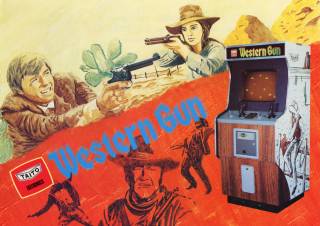
 Commodore 64
Commodore 64